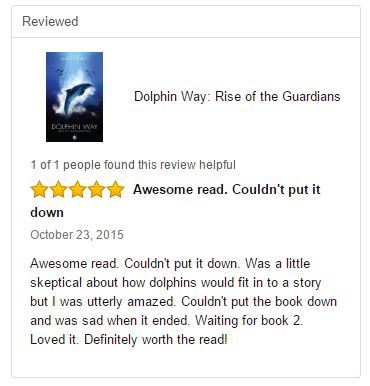Mark Caney's Blog, page 10
January 18, 2016
David Bowie’s Song ‘Heroes’ an Anthem for Dolphin and Whale Activists Worldwide
David Bowie is being remembered as a musical genius, a gifted artist and a fashion icon. But to whale and dolphin a ctivists, he was nothing short of a hero.
ctivists, he was nothing short of a hero.
Bowie’s hauntingly moving song “Heroes,” the title track of his 1977 album, has become a rallying cry for people around the world working to end the killing and capture of whales and dolphins at the cove in Taiji, Japan.
The song, which includes the lyrics “I, I wish you could swim/Like the dolphins, like dolphins can swim,” accompanies the closing credits of the 2009 documentary The Cove, which brought global attention to the annual slaughter in Taiji.
Most people don’t know that Bowie, a quiet but generous supporter of animal welfare causes who died on Sunday at 69, personally intervened to make sure the song could be licensed for a minimal fee.
The Cove director Louie Psihoyos said the movie’s producer, Fisher Stevens, knew Bowie’s wife, Iman. “That’s how we got through to him,” he said. “If we’d had to go through record-company channels, it never would’ve happened.”

Photo credit: Clare Oxenham
According to Psihoyos, the cost of licensing a rock song for commercial films starts at about $25,000 and can reach six figures. After hearing about the film, Bowie insisted that RCA Records make “Heroes” available for $3,000.
“They had to charge something so they weren’t giving it away,” Psihoyos said. “It was hardly worth the time for the record label to write up the contract.”
A licensing employee for Sony Music Entertainment, which owns RCA Records, confirmed that the fee was reduced but said the amount paid “is confidential.”
The song, reportedly about an East German and West German couple who meet at the Berlin Wall—“I, I can remember (I remember)/Standing, by the wall (by the wall)/And the guns, shot above our heads (over our heads)”—became a powerful anthem for the anti-whaling movement.
“I didn’t know at the time about his support for animal rights,” Psihoyos said of Bowie. “But it turns out he had a huge heart.”
Full story: EcoWatch

January 6, 2016
Bill to End Dolphin and Whale Captivity Reintroduced In Canada
A federal bill to end dolphin and whale captivity throughout Canada was reintroduced by Nova Scotia Senator Wilfred Moore in early December. The bill first made its appearance this past summer, at a time when the conservative Harper government held sway over Parliament. However, with the changing political climate in Canada — namely, the new Trudeau administration — things may be looking up for the whales and dolphins.
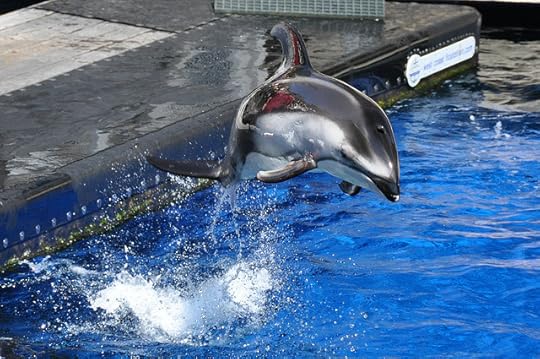 Dolphin at Vancouver Aquarium
Dolphin at Vancouver AquariumSource: Earth Island Journal

December 14, 2015
Horses meet dolphins video
Marky mark swimming with four dolphins this morning
Posted by Isola Racing Stables on Thursday, 15 October 2015

December 6, 2015
New images reveal for the first time how dolphins ‘see’ humans
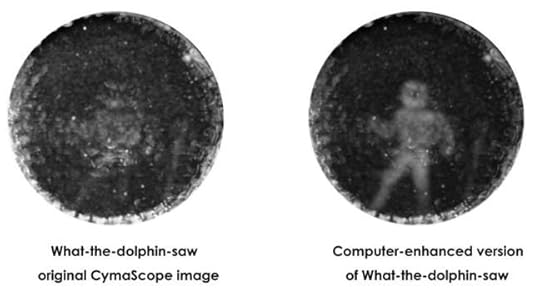 images conjured from a dolphin’s sonar have revealed how the creature “sees” a human swimmer using echolocation.
images conjured from a dolphin’s sonar have revealed how the creature “sees” a human swimmer using echolocation.
Scientists produced the blurred outlines of a submerged man after recording the sonar signals with an underwater microphone and converting them into pictures.
Sophisticated processing was used to transcribe the way sound waves imprint themselves on water and create the images.
A similar technique was used three years ago to capture a dolphin’s echolocation view of inanimate submerged objects, indicating that cetaceans really can “see” with sonar.
Team leader Jack Kassewitz, from the US-based SpeakDolphin project promoting communication between humans and dolphins, said: “This is the first time we have captured a what-the-dolphin-saw image of a submerged man.
“We employed a similar technique in 2012 to capture a dolphin’s echolocation picture of a flowerpot and several other submerged plastic objects but the present research has confirmed that result and so much more.”
The research, conducted with the help of British experts, took place at the Dolphin Discovery Centre in Puerto Aventuras, Mexico.
Underwater swimmer Jim McDonough wore a weight belt and exhaled most of the air in his lungs to overcome his natural buoyancy.
A decision was taken not to use breathing apparatus that would generate bubbles which could affect the results of the experiment.
The echo signal was sent via email to a UK scientist who has pioneered new technology called CymaScope that makes sound visible.
Acoustics physicist Dr John Stuart Reid, from Keswick, who heads the CymaScope team, said: “When I received the recording Jack had told me only that it might contain an echolocation reflection from someone’s face. I noticed the file name ‘Jim’ so I assumed that the image, if it existed within the file, would be that of a man’s face.
“I was somewhat dubious whether this could be achieved because the imaging we had carried out in 2012 was of simple plastic objects that had no inherent detail, whereas a face is a highly detailed form.”
He added: “I listened to the file and heard an interesting structure of clicks. The basic principle of the CymaScope instrument is that it transcribes sonic periodicities to water wavelet periodicities – in other words, the sound sample is imprinted onto a water membrane.
“The ability of the CymaScope to capture what-the-dolphin-saw images relates to the quasi-holographic properties of sound and its relationship with water … When I injected the click train into the CymaScope, while running the camera in video mode, I saw a fleeting shape on the water’s surface that did not resemble a face. I replayed the video, frame by frame and saw something entirely unexpected, the faint outline of a man.”
Computer processing enhanced and cleaned up the image producing more detail, including the weight belt worn by Mr McDonough.
The results suggest that dolphins can sense more than the shadow of an object with their echolocation, and are able to resolve surface features, said Mr Kassewitz.
He added: “The dolphin has had around 50 million years to evolve its echolocation sense whereas marine biologists have studied the physiology of cetaceans for only around five decades and I have worked with John Stuart Reid for barely five years. Even so, our recent success has left us all speechless.
“We now think it is safe to speculate that dolphins may employ a ‘sono-pictorial’ form of language, a language of pictures that they share with each other. If that proves to be true an exciting future lies ahead for inter-species communications.”
Source: bt.com

November 28, 2015
MTV Gives 5 Star Review for Dolphin Way on Amazon – Maybe a great Christmas present for someone?
November 26, 2015
Environmental groups decry WTO ruling on ‘dolphin safe’ tuna
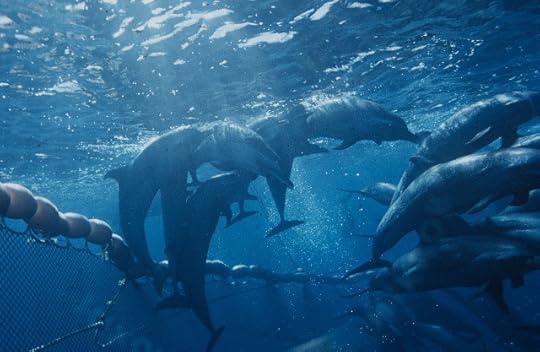 An international trade body’s ruling that US ban on Mexican yellow-fin tuna imports over a lack of ‘dolphin safe’ labels is illegal has been decried by environmental groups, Foodandwaterwatch.orgreported.
An international trade body’s ruling that US ban on Mexican yellow-fin tuna imports over a lack of ‘dolphin safe’ labels is illegal has been decried by environmental groups, Foodandwaterwatch.orgreported.
The ruling from the appellate body of the World Trade Organization (WTO) will allow the continuation of fishing practices that allow dolphins to wind up entangled in nets in countries such as Mexico, the groups fear.
The WTO’s ruling comes in the wake of a nearly 25-year battle over the ‘dolphin safe’ label. The appeal ruling is final, and could lead to Mexico making a claim for retaliation against US exports if it believes the United States has not brought its rules into line with the WTO ruling.
Full story: food & water watch

November 23, 2015
Tickling rats and giggling dolphins: do animals have a sense of humour?
There’s a video on YouTube (above) with over three and half million views, in which a girl appears to make a dolphin giggle by doing repeated cartwheels and handstands in front of its tank at a sea world centre.
We still understand relatively little about the extent to which emotions are present in animals, but could it be that the dolphin in this clip is experiencing one of the most distinctly human forms of expression – humour?
“I would define humour, as we know it, as seeing improbable connections in the upper mind,” says psychologist Jaak Panksepp. “That’s what a joke is all about. You’re not expecting it, and then all of a sudden … bang! It comes from the ability to put very strange, often illogical things together, triggering positive emotions.”
While the sophistication of human humour requires the medium of language, Panksepp says he would not be surprised if positive emotions could be trigged in some animals by viewing slapstick events which they find startling or surprising.
Dolphins have long intrigued animal researchers because of the complexity of their communication: a rich variety of clicks, buzzes, whistles and squeals of different rhythms, frequencies and lengths, as well as their capacity for self-recognition.
They are among a small group of species (which also includes chimpanzees, killer whales and magpies but not gorillas, dogs or giant pandas) which can pass the mirror test. A dye is used to place a dot above one of the dolphin’s eyes, before placing a mirror in its tank. The aim of the experiment is to see whether the dolphin can recognize the reflection as itself, or whether it perceives the dolphin in the mirror as a separate member of its species.
Humans are not capable of this before the age of around 15-18 months, a vital developmental stage which most species do not reach. However, it appears that dolphins do. When confronted with the mirror, they repeatedly circle their heads and move in closer to observe the eye which has been marked.
A dolphin is filmed interacting with its reflection in a mirror test, described above.
Mental self-recognition and the ability to place yourself in the context of a situation, is crucial to humour. Whether dolphins have the capacity to do this in some form remains open to debate, but we do know that they have a mode of communication which is akin to laughter.
Ten years ago, researchers studying dolphins at the Kolmården Wildlife Park in Sweden noticed a particular set of sounds they had never heard before – a short burst of pulses followed by a whistle. Taking closer note, they realized that the dolphins only ever made these signals during play-fighting, never during more aggressive confrontations. They concluded that the purpose of the sound was to indicate that the situation was pleasant or non-threatening, and to prevent it escalating into a real fight. For psychologists, this is the reason why laughter ever existed at all.
“The playfighting and tickling we see in animals are harmless attacks which serve a very social function,” says Peter McGraw, a psychologist at the University of Colorado. “Some of it is bonding and some of it can be learning to fight. But what you always see is that the animal that’s being attacked is the one making these vocalizations which we interpret as laughter. I believe that through evolution, laughter developed as way of showing that something which would otherwise be wrong, is actually ok.”
In our world, laughter has a variety of functions, ranging from the highly positive to negative or even sinister. But this complexity only really developed in the past 50,000 years, with the evolution of language, interdependent societies and culture. “Having language meant that the world of things which could seem odd, illogical or bizarre increased exponentially,” McGraw says. “And you laugh not just to say, ‘I get it, this is ok,’ but express a whole variety of feelings ranging from superiority to fitting in within a social group to filling gaps in conversation.”
Full story: The Guardian

November 19, 2015
Dolphins Almost Never Drown
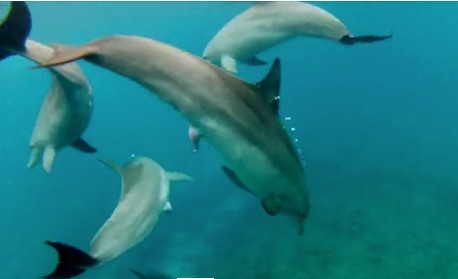 Being an air-breathing animal living in the ocean brings with it a number of challenges. Chief among them is trying not to drown. The paradox/problem of living in an aquatic environment but needing to be at the surface to breathe is something that manatees, sea turtles, whales, and dolphins have to cope with on a daily basis. But for dolphins, drowning in the traditional sense (which involves inhaling water into your lungs) is not really the problem.
Being an air-breathing animal living in the ocean brings with it a number of challenges. Chief among them is trying not to drown. The paradox/problem of living in an aquatic environment but needing to be at the surface to breathe is something that manatees, sea turtles, whales, and dolphins have to cope with on a daily basis. But for dolphins, drowning in the traditional sense (which involves inhaling water into your lungs) is not really the problem.
Dolphins, you see, are sort of immune to drowning.
I know what you’re thinking. This sounds like crazy nonsense. Don’t hundreds of thousands of dolphins drown in fishing nets each year? Well yes, a huge number of dolphins are killed by fishing nets each year. But no, most dolphins trapped in nets don’t drown.
They suffocate.
What’s the difference? It all has to do with what’s happening with a dolphin’s blowhole when they are trapped under water. Dolphins are conscious breathers. This means that a dolphin must think about and decide on every breath it takes. Humans, in contrast, have the ability to let our brainstem take over the breathing duties, allowing us to continue to take breaths even when unconscious or asleep. Dolphins do not have this luxury.
This conscious-breathing setup means dolphins have evolved a strange relationship with their blowholes. A dolphin’s blowhole – which is the only pathway to a dolphin’s lungs – is closed by a sort of flap, which is attached to a very strong set of muscles. When closed, this flap creates a water-tight seal. The blowhole flap remains – by default – in the closed position. Below the blowhole are a series of internal flaps, valves, and other fleshy portals all of which create their own airtight seals – essentially creating four separate barriers between the outside air and a dolphin’s lungs. So if a dolphin is just hanging about in the ocean not thinking about taking a breath, it doesn’t have to worry about letting water into its lungs – the blowhole and other muscle-seals are tightly shut, and waiting on orders from the dolphin’s conscious mind to open up and let in air.
This means that if a dolphin were to ever be knocked unconscious, he/she would sink to the seafloor, and come to rest at the bottom with their blowhole firmly shut. Should the dolphin fail to awaken before they run out of oxygen, they will die – not from drowning (that is, inhaling water), but from suffocation. Something similar happens if a dolphin were to be trapped in a fishing net. Humans, when trapped under water and in desperate need of air, will almost always open their mouths and make one final, desperate attempt to breathe, sucking water into their lungs. It is rare for a human to suffocate under water without taking a final breath that fills their lungs with water.
A dolphin, on the other hand, is far less likely to inhale water this way. Although they might crave air just as desperately as a human, the blowhole and sphincter-seal system in their nasal cavity typically remains in the default, shut position.
Occasionally, dolphins that are sick might accidentally inhale water and drown if they are too weak to keep their heads above water. And some dolphins trapped in nets are so overcome by panic that they are able to override the seal-system and open their blowholes, allowing water into their lungs.
But it is likely that most dolphins trapped in a net will ultimately succumb to suffocation as they run out of oxygen, and die with their blowhole closed. This is a terrible, if all too common fate for a dolphin, or any other air-breathing sea creature.
Want to read more zany dolphin science trivia? Order a copy of the book Twenty-Two Fantastical Facts about Dolphins
Source: Huffington Post

November 12, 2015
Allowing scallop dredging in ‘strictly protected’ dolphin reserves is madness
Three weeks ago, a friend and I took our kayaks down to Cardigan Bay, and launched them onto a flat sea. Even from the beach we could see that something was happening: the sea serpent heads of cormorants were emerging from the water with mackerel in their beaks, while gulls squabbled over the smaller fish being driven to the surface.
By the time we were half a mile from the shore, we found ourselves surrounded by great flocks of herring gulls, guillemots and razorbills, sitting on the surface, watching a constellation of tiny flashes as shoals of sandeels were herded by the mackerel far below. Every so often, as a shoal was driven towards the surface, the gulls would go mad, squawking and fighting and dipping their heads into the water, and the diving birds would disappear into the sea.
A little further out, we found ourselves among the top predators. We saw them from a distance at first, breaching and blowing. But soon they surrounded us, coming at times within three metres of the boats: bottlenose dolphins, scooping up mackerel as they sleeked past. They seemed unhurried, swimming steadily in a wide circle, emerging with a brief puff every few metres in a rhythm as regular as clockwork.
Occasionally, one would leap out of the water, sometimes twisting or cartwheeling before crashing back into the sea, prompted, it seemed, by nothing but exhilaration. The dolphins circled us for about an hour before disappearing towards the horizon.
The original meaning of the word ecstasy is “standing outside oneself”. It is an accurate description of how I felt. Everything that weighs on my mind, that tethers me to the world of thought and work and care sloughed off. Experiences like this are among the defining moments of my life, that I will remember even if I forget all else.
The dolphins in Bae Ceredigion (Cardigan Bay) are Britain’s largest breeding population. People come from all over the country to watch them and experience something unavailable almost anywhere else in Britain: encounters with megafauna.
As you might expect, much of the water in which they live is, on paper, protected. Two of the areas in which they hunt and breed have been granted the highest designation available under European law: a Special Area of Conservation (SAC). The Bae Ceredigion and Pen Llŷn a’r Sarnau SACs cover significant parts of the bay, though there is plenty of sea used by the dolphins that is still without protection.
So here’s a simple quiz for you. What is the most appropriate way to manage the SACs set aside to support our largest population of bottlenose dolphins? I’ll give you two options:
1. Allow the dolphins and other marine life to recover from decades of ecological destruction caused by the fishing industry and to flourish once more.
2. Allow beam trawlers and scallop dredgers to operate inside these “protected areas”, ripping the seafloor to shreds and destroying almost all the living creatures the SACs contain.
You didn’t choose option 1, did you? What were you even thinking?
You plainly need a lesson from the Welsh government. It believes that the appropriate way in which to manage a SAC is to rip it to pieces.
Last month it launched a consultation on reopening sections of the Bae Ceredigion SAC to scallop dredging. Already the dredgers are allowed into part of the reserve. Now, if the government gets its way, they will be able to extend the area in which they operate. The consultation doesn’t mention beam trawlers, however, for the simple reason that they are already allowed to work throughout the “protected” areas.
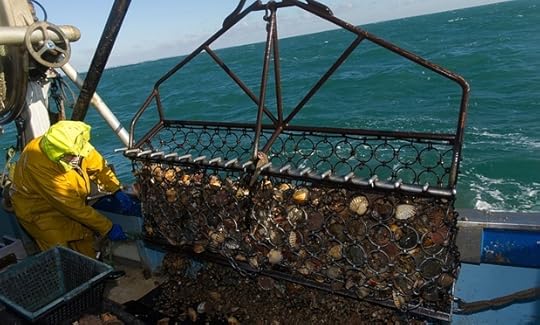 Scallop dredges are rakes with long steel tines that dig into the seafloor, towed at great speed by boats. They tear out the entire structure of the seabed, and catch the scallops in chainmail baskets.
Scallop dredges are rakes with long steel tines that dig into the seafloor, towed at great speed by boats. They tear out the entire structure of the seabed, and catch the scallops in chainmail baskets.
Sea floors that have not been dredged or trawled tend to be covered with a dense reef of living creatures: oysters, fan mussels and many other shelly species, soft corals, sea pens, sea fans, sponges, coralline seaweeds, peacock worms and anenomes. Living among them are lobsters and crabs of many species, as well as a great variety of fish.
When bottlenose dolphin calves are young, their mothers rely for much of their food on slow or sedentary animals on the seafloor*, as they cannot travel fast or far at this time. Sustaining a healthy dolphin population, in other words, means sustaining a healthy seabed.
Read full story: The Guardian by George Monboit

November 10, 2015
SeaWorld to end killer whale shows in wake of mounting protests
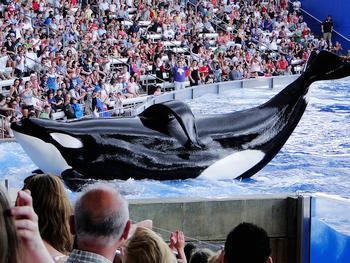 SeaWorld will end orca shows at its theme park in San Diego as part of a comprehensive overhaul of the company in the wake of mounting protests over its treatment of animals.
SeaWorld will end orca shows at its theme park in San Diego as part of a comprehensive overhaul of the company in the wake of mounting protests over its treatment of animals.
The company, which has lost half of its market value since the 2013 release of Blackfish, a film cataloguing alleged mistreatment of killer whales at its parks, said on Monday that it would phase out killer whale shows at its California park by 2017.
“We are listening to our guests, evolving as a company, we are always changing,” said chief executive Joel Manby. “In 2017 we will launch an all new orca experience focused on natural environment [of whales]. 2016 will be the last year of our theatrical killer whale experience in San Diego.”
The San Diego Union Tribune reported that SeaWorld’s Shamu stadium would be replaced by an “informative” experience designed to take place in a more natural setting that would carry a “conservation message inspiring people to act”.
“People love companies that have a purpose, even for-profit companies,” Manby told investors.“Just look at WholeFoods … I don’t see any reason why SeaWorld can’t be one of those brands.
SeaWorld’s announcement comes just days after Congressman Adam Schiff said he would introduce legislation forcing SeaWorld to end the captivity of orcas. “The evidence is very strong that the psychological and physical harm done to these magnificent animals far outweighs any benefits reaped from their display,”Schiff said. “We cannot be responsible stewards of our natural environment and propagate messages about the importance of animal welfare when our behaviors do not reflect our principles. The Orca Act ensures that this will be the last generation of orcas who live in captivity, and we will appreciate these incredible creatures where they belong – in the wild.”
Manby told investors that the company was going to refocus on conservation of animals rather than using them as entertainment.
SeaWorld’s change in direction comes as the company battles against a mounting public backlash after Blackfish, which focuses on the death of a trainer who was dragged into the water and drowned by an aggressive bull whale, helped turn what was a fringe animal rights issue into a national and international debate. Celebrities including Harry Styles, Matt Damon and Jackass’s Steve-O have waded in, pushing the anti-SeaWorld message to the company’s target youth market across the world.
The backlash has hit the company, and its investors, where it hurts. SeaWorld’s shares have halved since the film came out in July 2013. The shares treaded water at $18.21 on Monday.
Watch a clip from Blackfish, the 2013 documentary about killer whales in captivity
SeaWorld has dismissed Blackfish as “propaganda” and “emotionally manipulative” and spent $15m on a TV and social media campaign to counter negative sentiment and promote the work it does to protect and care for whales and other animals.
“All of the falsehoods and misleading techniques in Blackfish are employed in the service of the film’s obvious bias, one that is best revealed near the end of Blackfish by a neuroscientist with no known expertise in killer whales. She claims that all killer whales in captivity are ‘emotionally destroyed’ and ‘ticking time bombs’,” SeaWorld said. “These are not the words of science, and indeed, there is not a shred of scientific support for them. Rather, they are the words of animal rights activists whose agenda the film’s many falsehoods were designed to advance. They reveal Blackfish not as an objective documentary, but as propaganda.”
SeaWorld has concentrated on telling customers the “69 reasons you shouldn’t believe Blackfish”, it was revealed this summer to have sent an employee undercover to infiltratePeta, the main animal rights activist group campaigning for the release of the whales from the tanks and into coastal sanctuaries.
Manby has admitted that the company, whose attractions include making whales perform tricks in front of hundreds packed into Shamu stadium and charging guests an extra $215 for 20 minutes playing with dolphins, has so far failed to “evolve the SeaWorld brand to match the changing expectations of our guests”.
SeaWorld had hoped for a good public relations bounce from its plan to nearly double the size of its San Diego whale tank complex to 9.6m gallons. The biggest of the new tanks would be 255ft long, compared to 125ft currently. The average adult male orca is 28ft long, meaning the pool is 4.5 body lengths long.
But the plan backfired last month when the California coastal commission ruled that the company could only expand the tanks if it put an end to breeding orcas at the park. SeaWorld – which had said the $100m Blue World Project expansion of the tanks, which date back to the 1960s, was essential for the health of the animals – had vowed to fight the ban through the courts.
Source: MSN News


